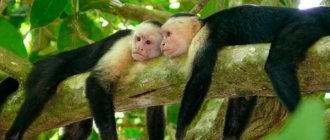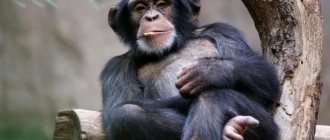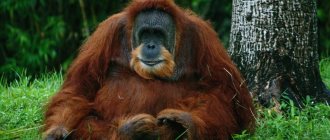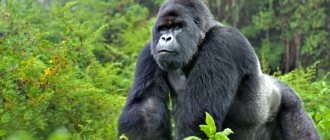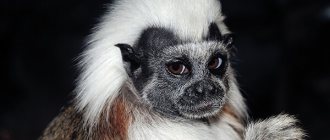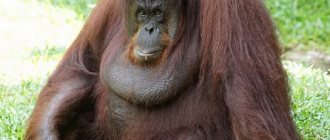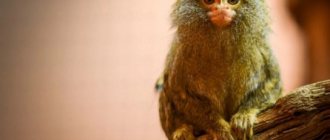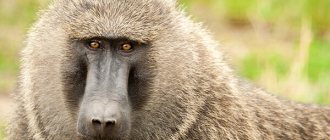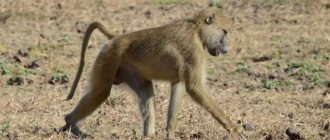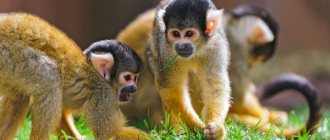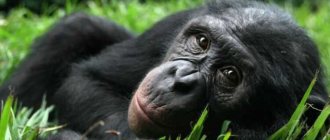- Wild animals
- >>
- Mammals
Bonobos (pygmy chimpanzees) - gained fame due to unusual sexual activity, which was used by the primate as a way of communicating in a group. These animals are less aggressive, unlike chimpanzees, and try to resolve conflict situations through sex, thus eliminating conflicts, or as reconciliation after a quarrel and getting rid of accumulated emotions. Sex among bonobos serves to form social bonds. If you have questions about these primates, check out this post.
Origin of the species and description
Photo: Bonobos
Fossils of the species Pan paniscus were not described until 2005. Existing chimpanzee populations in West and Central Africa do not overlap with major fossil sites in East Africa. However, fossils are now reported from Kenya.
This indicates that both humans and members of the Pan family were present in the East African Rift Valley during the Middle Pleistocene. According to A. Zihlman, bonobo body proportions are very similar to those of australopithecus, and leading evolutionary biologist D. Griffith has suggested that bonobos may be a living example of our distant human ancestors.
Video: Bonobos
Despite the alternative name "pygmy chimpanzee", the bonobo is not particularly diminutive compared to the common chimpanzee, with the exception of its head. The animal owes its name to Ernst Schwarz, who classified the species after observing a previously mislabeled bonobo skull that was smaller in size compared to its chimpanzee counterpart.
The name "bonobo" first appeared in 1954, when Eduard Paul Tratz and Heinz Heck proposed it as a new and distinct general term for pygmy chimpanzees. The name is believed to have been misspelled on a shipping crate from the town of Bolobo on the Congo River, near where the first bonobo specimens were collected in the 1920s.
Keeping primates at home
Before you get a chimpanzee at home, you need to be aware that this is not just a pet, but something more. The bonobo is quite demanding in terms of care and requires a lot of time and attention, because it must be looked after like a human child.
A pygmy chimpanzee (even an adult) needs to be raised like a small one: taught various skills and educated.
The most interesting thing about keeping bonobos is that these primates will pleasantly surprise the breeder with their abilities literally every day.
Appearance and features
Photo: What a bonobo looks like
Bonobos are apes about two-thirds the size of humans with dark hair covering their bodies. The hair is generally longer than that of common chimpanzees, and this is especially noticeable on the cheeks, which are relatively hairless in P. troglodytes. The parts of the body that are not covered with hair (i.e. the middle of the face, arms, legs) are dark in color throughout life. This contrasts with common chimpanzees, which have lighter skin, especially when young.
Bonobos walk on two legs more often than chimpanzees. They have longer limbs, especially their hind limbs, compared to common chimpanzees. Sexual dimorphism exists and males are approximately 30% heavier, ranging from 37 to 61 kg, with an average of 45 kg, and females ranging from 27 to 38 kg, with an average of 33.2 kg. However, bonobos are less sexually dimorphic than many other primates. Average height is 119 cm for men and 111 cm for women. The average capacity of the skull is 350 cubic centimeters.
The bonobo is generally considered to be more graceful than the common chimpanzee. However, large male chimpanzees outweigh any bonobo. When the two species stand up, they are almost the same size. Bonobos have relatively smaller heads than chimpanzees and have less distinct eyebrows.
Interesting fact: Physical characteristics make bonobos more human-like than the average chimpanzee. This monkey also has very individual facial features, so that one individual can look significantly different from another. This characteristic is adapted for visual recognition of faces in social interaction.
He has a dark face with pink lips, small ears, wide nostrils, and long hair parted in the middle. Females have a slightly more convex chest than other monkeys, although not as noticeably as in humans. In addition, the bonobo has a slender figure, narrow shoulders, a thin neck and long legs, which significantly distinguishes it from ordinary chimpanzees.
Now you know what a Banobo monkey looks like. Let's see where she lives.
Where do bonobos live?
Photo: Bonobos in Africa
Bonobos live in the tropical forests of Africa, located in ]Congo[/anchor] (formerly Zaire). The bonobo's habitat is in the Congo River Basin. This area is located south of the arc formed by the Congo River (formerly the Zaire River) and its headwaters and the Lualaba River, north of the Kazai River. In the Congo Basin, bonobos live in several types of vegetation. The area is generally classified as rainforest.
However, local agriculture and areas that have returned to the forest from agriculture ("young" and "aged secondary forest") are mixed. The species composition, height and density of trees differ in each individual case, but all are intensively used by bonobos. In addition to forested areas, they are found in swamp forests, on plants exposed in marshy areas that are also used by this monkey.
Feeding occurs in each type of habitat, and bonobos go to sleeping forest areas to sleep. Some bonobo populations may have a preference for sleeping in relatively small (15 to 30 m) trees, especially in forests with secondary vegetation. Bonobo populations have been found ranging from 14 to 29 km². However, this reflects observational data and is not an attempt to reflect the size of the home range of any particular group.
What do bonobos eat?
Photo: Bonobo monkey
Fruits make up the majority of P. paniscus's diet, although bonobos also include a wide range of other foods in their diet. Plant parts used include fruits, nuts, stems, shoots, pith, leaves, roots, tubers and flowers. Mushrooms are also sometimes consumed by these monkeys. Invertebrates make up a small part of the diet and include termites, larvae and worms. On rare occasions, bonobos have been known to eat meat. They have directly observed eating rodents (Anomalurus), forest duikers (C. dorsalis), black-faced duikers (C. nigrifrons) and bats (Eidolon).
The bonobo's main diet consists of:
- mammals;
- eggs;
- insects;
- earthworms;
- leaves;
- roots and tubers;
- bark or stems;
- seeds;
- grains;
- nuts;
- fruits and flowers;
- fungus.
57% of the bonobo's diet consists of fruits, but leaves, honey, eggs, meat of small vertebrates and invertebrates are also added to this. In some cases, bonobos may consume lower-level primates. Some experts who observe these primates claim that bonobos also practice cannibalism in captivity, although this is disputed by other scientists. However, at least one confirmed case of cannibalism in the wild of a dead cub was described in 2008. Characteristics and lifestyle
Bonobos are social animals that travel and feed in mixed groups: males + females + juveniles. Typically in groups of 3 to 6 individuals, but there can be up to 10. Near abundant food sources they gather in large groups, but as they move they divide into smaller ones. This pattern is similar to the fission-fusion dynamics of chimpanzees, with group size typically limited by the availability of certain foods.
Male bonobos have a weak dominant structure. They remain in their natal group for life, while females leave during adolescence to join another group. Increased dominance of bonobo males correlates with the presence of a mother in the group. Dominance is manifested through threats and is often associated with gaining access to food. Most threats are unidirectional (the intruder retreats without challenging). Older females gain social status as their offspring become dominant. Bonobos are agile in trees, climbing or swinging and jumping between branches.
Interesting fact: While on vacation, caring for each other is a common activity. It occurs most often between male and female individuals, although occasionally between two females. This is not interpreted as greeting, courtship, or tension relief, but rather as intimacy or a group-building activity.
Much of the research on bonobos has centered around their use of sexual behavior in non-productive contexts.
These non-copulatory behaviors include:
- contact between woman and woman;
- man and man;
- a long period of imitation of juvenile and adolescent copulation.
The scientists documented the frequency of this behavior between each pair of group members. This behavior is observed in women, especially when entering a new group after leaving the previous one, and in feeding areas where a large amount of food is found. These sexual behaviors may be a way of negotiating and enforcing status differences for both women and men.
Cannibalism in primates
Do bonobo monkeys eat their own kind? Yes, this is a confirmed fact. But cannibalism in primates should not be considered as something special, outstanding, or out of the ordinary. It's not just chimpanzees who eat their offspring.
As you know, hamsters, pigs, beetles, birds, fish and other living creatures are not averse to feasting on their descendants. This is quite strange, not only because we humans consider eating our children unacceptable. This is also strange because the production of children is actually the main goal of all living organisms. So eating them, and as a result, the genes they carry, is the best way to harm yourself.
These types of behavior disappear quite quickly from the population. The fact that many species resort to cannibalism from time to time shows that it can sometimes be a successful survival strategy.
Bonobos use eating their children as a form of population control.
Social structure and reproduction
Photo: Baby bonobo
Female bonobos can handle any male in the group except their sons. They go into estrus, marked by severe swelling of the perineal tissue, lasting 10 to 20 days. Matings are concentrated during maximum swelling. Reproduction occurs throughout the year. The female may resume external signs of estrus within a year after giving birth. Before then, copulation may resume, although it will not result in conception, indicating that the female is not fertile.
During this period, she continues to breastfeed until her children are weaned at around 4 years of age. The average birth interval is 4.6 years. Lactation may suppress ovulation, but not external signs of estrus. Because no study has lasted longer than the bonobo's lifespan, the total number of offspring per female is unknown. This is approximately four descendants.
Interesting fact: There is no clear pattern for mate selection: women court many of the men in the group during estrus, with the exception of their sons. Because of this, paternity is usually unknown to both partners.
Bonobos are highly social mammals, living about 15 years before reaching full adult status. During this time, the mother provides most of the parenting, although males may make indirect contributions (e.g., alerting danger groups, sharing food, and helping to protect children).
Bonobos are born relatively helpless. They depend on their mother's milk and cling to their mother for several months. Weaning is a gradual process that usually begins at age 4 years. Throughout the weaning process, mothers typically hold food for their babies, allowing them to observe the feeding process and food choices.
As adults, male bonobos typically remain in their social group and associate with their mothers for their remaining years. Female offspring leave their group, so they do not maintain contact with their mothers into adulthood.
Completion
So, it is obvious that it is possible to have a chimpanzee at home. Caring for bonobos is easy, as long as you have enough time to do it.
In conclusion, we can once again note the pros and cons of keeping pygmy chimpanzees at home.
Pros:
- bonobo chimpanzees are very friendly, so you can have them at home without fear,
- Such primates are completely undemanding when it comes to care,
- they can be successfully trained,
- They easily get along with other pets.
Minuses:
- when stressed, chimpanzees can turn over the entire house,
- bonobo monkeys need attention 24 hours a day,
- feeding such a primate is a very costly and expensive undertaking.
Natural enemies of bonobos
Photo: Bonobo chimpanzee
The only reliable and dangerous predators of bonobos are humans. Although hunting them is illegal, poaching is still common throughout much of their range. Humans hunt chimpanzees for food. It is also believed that leopards and pythons, which prey on common chimpanzees, may feed on bonobos. There is no direct evidence of predation on these primates by other animals, although there are some predators that are likely candidates for incidental consumption of bonabos, especially juveniles.
The most famous predators include:
- leopards (P. pardus);
- pythons (P. Sabae);
- martial eagles (P. bellicosus);
- people (Homo Sapiens).
These animals, like common chimpanzees, have many of the diseases that affect humans, such as polio. In addition, bonobos are carriers of various parasites, such as intestinal helminths, flukes and schistosomes.
Bonobos and common chimpanzees are the closest relatives of Homo sapiens. It is an invaluable source of information for the study of human origins and disease. Bonobos are popular with people and can be useful for habitat conservation. The amount of fruit consumed by these primates suggests that they may play an important role in dispersing the seeds of plant species they eat.
Nutrition
These monkeys are omnivores. The main food product that bonobos eat is fruit. In addition, they love herbaceous plants, leaves and invertebrates. A small percentage of their diet comes from animal foods. They can eat squirrel, small antelope, another type of monkey. Sometimes they practice cannibalism. In 2008, there was one case in which a deceased baby bonobo was eaten.
Population and species status
Photo: What bonobos look like
Estimates of numbers range from 29,500 to 50,000 individuals. The bonobo population is believed to have declined sharply over the past 30 years, although accurate surveys have been difficult to conduct in war-torn central Congo. The main threats to bonobo populations include habitat loss and hunting for meat, with shooting activity increasing sharply during the first and second Congo Wars due to the presence of armed militias even in remote areas such as Salonga National Park. This is part of a larger trend towards the disappearance of these monkeys.
Interesting fact: In 1995, concerns about the decline of bonobos in the wild led to the publication of a conservation action plan for the species. This is the collection of population data and the identification of priority activities for bonobo conservation.
Today, stakeholders discuss threats to bolobos on several scientific and environmental websites. Organizations such as the World Wide Fund for Nature, the African Wildlife Foundation and others are trying to focus attention on the extreme risk to this species. Some suggest creating a reserve in a more stable part of Africa or on an island in a place like Indonesia and moving part of the population there. Local awareness is constantly growing. Various groups have been created on the Internet to collect donations to help preserve the bonabo.
